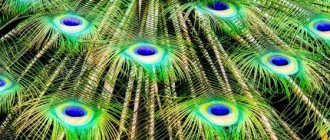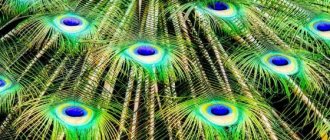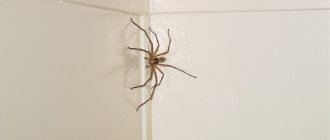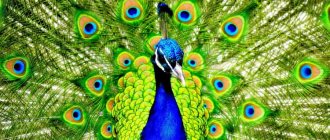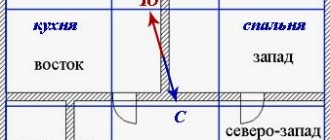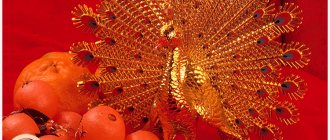Due to its colorful plumage, the peacock has been a symbol of the sun in southern Asian countries. It represented diversity, joy of life, beauty, longevity and love. The bird's bushy tail was associated with nobility, power, glory, greatness and pride. In India and Byzantium, the peacock was revered as a royal bird. Indians considered the peacock a symbol of fertility and abundance, the animal of the god Brahma, as well as an attribute of Lakshmi, the god of passionate love Kama, the wise goddess Saraswati - the patroness of the arts, music and poetry. The motif of Krishna dancing with the peacocks symbolized life as a holiday, joy and admiration of all that is beautiful.
The incarnation of the god Vishnu - Krishna dances and rejoices while peacocks watch him
There were legends about the peacock that he, as a messenger of the sun, fights his enemies - snakes, and by killing them, converts snake venom into solar energy.
The Iranian cosmogonic myth of the races says that God first created the peacock as the embodiment of the world soul. Afterwards, he let the peacock see his reflection in the magic mirror, and the peacock was delighted with his beauty.
Peacock - coat of arms of the Chinese imperial Ming dynasty
Droplets of sweat shed by the peacock fell to the ground, and from them came all life on earth.
In the Islamic tradition, the peacock was considered the personification of the cosmos and was often depicted as a symbolic representation of the sun and moon. The Yazidi sect, “devil worshipers,” interpreted the peacock as a messenger of God, the king. They call him Malaki-Taus (or Melek-Tauz), a fallen angel who is also associated with the active transformative power of the cosmos.
Constellation Pavo. Illustration from Astronomical J. Amigoni. Juno receives the head of Argos. atlas “Uranography” by J. Hevelius
In classical Islam, the peacock is used as a symbol of the dual nature of man, royal power, and a metaphor for pure, unclouded contemplation of truth. The meanings of the peacock associated with admiration, true vision, and contemplation are most likely associated with the abundance of white spots similar to “eyes” on its feathers.
In modern Europe, the symbolism of the peacock received a negative connotation, including due to the fact that such a beautiful bird had a disgusting voice. The peacock came to be considered a symbol of arrogance, pomposity, pride and vanity.
Coat of arms of Serpukhov
Symbol of countries and cities
National bird of India
The blue peacock was officially elected as the national bird of India in 1963. The choice was between him and the bustard. The association of the royal bird with Indian culture has an ancient history. Birds were deified by the ancient Hindus, as evidenced by the myths that have reached us.
The peacock has been involved in the life of a Hindu since childhood - he is the hero of fairy tales and legends, songs and poems.
Birds live near cities and settlements, therefore they are in interaction and close connection with the local population.
The greatness and beauty of this feathered representative of the fauna is combined with an unpretentious disposition, which is why it is rightfully called the national bird of India.
Other countries and cities
The green peacock has been the national symbol of Myanmar since 1940. The culture of the country was greatly influenced by the royal nobility of India, so the similarity of the symbols of the states is natural.
In the ancient Egyptian Heliopsis there was a temple of the sun, so a representative of the pheasant family, as a sign of the luminary, became a symbol of this city.
The symbol of the peacock or its feather is widely represented in heraldry. In Russia this is the city of Serpukhov.
The bird also adorns the coat of arms of cities:
- Newark-on-Trent (Britain);
- Albach (Germany);
- Saint-Paul-Cap-de-Joux (France);
- Pego (Spain).
Additional superstitions
In Muslim folklore, there is a legend that a peacock opened the gates of heaven, through which the devil himself entered. Therefore, Muslims also have a wary attitude towards this bird. Muslims cannot become attached to such a treacherous bird.
In Ancient Rome and Ancient Greece, on the contrary, peacock feathers had a sacred character. They were used for religious rituals; such an element could only be found on the territory of temples. It was believed that a mere mortal who was not a priest was strictly forbidden to pick up a peacock feather. The punishment for such insolence was the death penalty.
In ancient times, among the British, peacock feathers were not held in high esteem in the house. It was believed that if unmarried girls lived in the house, then because of the pen they would not be able to get married for a long time. Also, parts of the bird's tail were placed inside the witches' house. It was believed that with the help of the bird's voice one could cause torrential rains over the city.
Do you know what peacock feathers mean in a house omen? If you don’t know this yet, then we hasten to talk about this sign. Here you will learn that the appearance of peacock feathers in the house can mean both good and bad.
Universal symbol
Divine Bird
- In India, the peacock is a sacred bird. Religions in other countries also use this symbol.
- Representatives of Christianity respect birds, considering them a symbol of divine reverence. The “eyes” on the feathers symbolize the “all-seeing” Church. The ability to renew (change plumage) has caused Christians to associate it with immortality. And the legend that speaks of the incorruptibility of the meat of this bird made the peacock a symbol of resurrection. He is often depicted on icons dedicated to Christmas. The Great Martyr Barbara holds in her hand the feather of a sacred bird as a sign of her immortality.
- Buddhism recognizes the bird as a symbol of compassion and vigilance. His feather is an attribute of Avalokiteshvara.
- In Islam, the peacock's "eye" symbolizes clairvoyance and intuition.
- In the Yazidi religion, the archangel Tausi Malak appears in the form of a peacock.
- Peacock feather is an attribute of Lord Krishna. For Hare Krishnas, this bird symbolizes immortality. The "Eye" represents the all-seeing eye of Krishna.
Symbol of the Chosen
In ancient China, the emperor encouraged his subjects by giving them a feather from a sacred animal. Having received the favor of the emperor, the Chinese were ranked among the highest strata of society. Therefore, the talisman is still used as a symbol of dignity and greatness. The beautiful bird is the totem animal of the Ming Dynasty.
In Iran, the Shah's court was called the "Peacock Throne".
In Rome, bird feathers were the emblem of the empress and her daughters. The image of a peacock was used on coins as a sign of the divinity of the imperial daughters.
Astral symbolism
In Ancient Greece, the peacock's tail, decorated with multi-colored patterns and precious stones, was the embodiment of the endless starry sky. One of the myths tells of the revival of the hundred-eyed Argos by the goddess Hera, who transferred the eyes of the sleepy hero to the tail of a beautiful pheasant.
According to the legends of the ancient world, these birds symbolize the entire cosmos or the moon and sun separately.
Compromise solution
So is it possible to keep peacock feathers at home? Practice shows that there is no clear answer to the question posed, since each of the two “camps” - supporters of storing these items and its opponents - has a lot of its own arguments. As for the compromise option, fortunately, it is quite possible here: anyone who is afraid of the “look of the devil’s eyes” emblazoned on their feathers can be advised to acquire an elegant peacock miniature. There are two main types of it:
- With a folded tail shape, which above all means caution. First of all, it makes sense to give such a figurine to people whose activities involve a certain risk, for example, businessmen.
- With a spread tail, each “eye” of which is clearly visible. Such miniatures can be recommended to anyone who wants to have a good personal life.
No less positive is the meaning of a peacock depicted in a painting or made through embroidery. It brings good luck to its owner, attracting positivity like a magnet and ensuring success in all endeavors. At the same time, you can not only buy such a thing, but also make it yourself: draw or embroider using a wide palette of bright colors needed to convey all the beauty of peacock feathers.
Peacock in a dream
A peacock appearing in a dream can symbolize hopes and fantasies or an arrogant person.
- Feeding a bird in a dream means that an approach will be found to an unapproachable person.
- According to the dream book, seeing a peacock spreading its tail in a dream is a sign of deception. If the tail is not loose, this means minor troubles.
- If a peacock loses a feather in a dream, it means exposing an influential person.
- You dream of a screaming peacock to remind you of some small but important matters.
- A dream from Wednesday to Thursday promises a fun pastime for the rest of the week. And if you dreamed about the bird from Sunday to Monday, then renovations will soon begin in the house.
Interpretation of Slavic signs
Domestic signs associated with peacocks do not carry any positive interpretations. This may be due to the fact that these birds are not found in nature in Russia. People have developed some distrust of peacocks, which is why they began to be wary of using feathers in the house. Also, the basis for negative explanations for the peacock feathers at home is the wide spread of Christianity in Russian territories, which denies the worship of any talismans, except for icons of saints and the cross.
The Slavic people believed that the presence of an element from a peacock's tail inside the house as a means of attracting money leads to disgrace of the family, discord, swearing and even serious fatal diseases. This is why you should not display the tail of this bird as decoration.
In works of fiction there are also reservations that peacock feathers bring misfortune within the family. In the work “Gone with the Wind,” one of the characters said that peacock feathers in the house are a sign of trouble.
Bad omens are associated with the eye depicted on the feather, which can be associated with the eye of the devil.
Negative symbol value
Only the rich classes could breed peacocks. Due to its association with luxury and vanity, the bird has become a symbol of arrogance and arrogance. Hence the expression “spread its tail like a peacock.” In mockery of feigned arrogance, the famous Faina Ranevskaya once said: “Under the most beautiful peacock tail hides the most ordinary chicken ass. So less pathos, gentlemen".
In England it is not customary to keep peacock feathers in the house. "Eye" reminds the English of the evil eye and is associated with bad luck. The British believe in omens: the owner may be in big trouble; and the unmarried women in the house will not find a husband.
In South Asia, the bird is considered a harbinger of trouble. She warns of approaching predators and thunderstorms.
The emergence of a belief
The first beliefs about peacock feathers in the house were found in the territories of China. Which is not surprising, since the bird’s homeland is Asian countries. Drawings depicting these birds were present on family symbols of the Ming Dynasty. That is why the eastern people love peacocks very much and consider it a great honor to keep a piece of this beautiful bird in their home.
All world cultures and nationalities have different attitudes towards peacocks. In some countries, people revere this bird and consider it a symbol of wisdom. Also, you can use a peacock feather for them inside the house, because it brings knowledge and science.
Some countries symbolize these noble birds with fearlessness, pride, immortality. Because of the pattern depicted on the feathers in the form of the eye of an unknown animal.
IT IS IMPORTANT TO KNOW! Baba Nina: “To escape from lack of money once and for all, make it a rule to wear simple things..” Read the article >> https://c.twnt.ru/pbH9
References to peacocks are important in Buddhist traditions. According to their explanations, the feathers of this bird act as an element of compassion and are an attribute of Buddha.
Peacock feathers in the home
In contrast to the folk signs of the British, the teachings of Feng Shui equate peacocks with a deity. And the white peacock is a symbol of spirituality and spiritual harmony. Bird feathers are attracted to the home:
- wealth;
- luxury;
- success in business;
- Love;
- beauty;
- fantasy.
It is possible to put things in order at work or get a promotion with the help of this talisman.
Bird feathers placed in the house of a lonely person will attract love to the house.
It is possible to “appease” the talisman so that it works with the help of praise.
Feng Shui interpretation
The Asian teaching of Feng Shui favors the presence of peacock feathers in the house. It is believed that such an element attracts wealth and prosperity into the home. It is important that the tail feather is large, intact and bright. Also, according to Feng Shui, it would not be superfluous to place a peacock figurine on your desktop. Such an element will act as a talisman for career advancement.
The figurine should be made of either gilded material or porcelain with elements of precious stones. In some cases, it is possible to make a peacock talisman yourself. As a material, using clay. In this case, special attention should be paid to painting the figurine. The palette of colors should be bright and rich; pale colors should not be used. Only then will the talisman work to attract commercial success.
Chinese masters have calculated that there are more than three hundred and fifty shades, colors, and tones on the peacock’s tail. That is why Asian peoples treat such an important, beautiful bird with love and reverence. They consider her strong, smart, independent.
One of the important conditions for marking good events with peacock feathers is their beauty and integrity.
Negative side
If we turn to folk signs, then it is impossible to keep any signs of a peacock in the house. Beliefs explain why feathers should not be used as a talisman or to attract money or happiness. Such an element brings misfortune, swearing, nonsense or even death. If we turn to world literature. You can find many explanations for this fact. Thus, in the work “Gone with the Wind” it was indicated that feathers bring misfortune and misfortune.
During the production of the play “Othello,” one of the actors made a remark to a woman sitting in the second row. He sent her a note with the following content: “For God’s sake, take away your peacock feather fan, don’t bring misfortune to the theater.” When the woman wanted to give her fan to the theater worker, he refused to take it in his hands. Signs provide a logical explanation for this behavior.
Peacock feathers bring misfortune and misfortune
According to Muslim legend, the peacock opened the gates of heaven, through which the devil himself passed. On the other hand, only church and temple ministers could use such an item. The pen has been sacred since the times of ancient Greece and Rome. That is why a mere mortal should not pick it up. There is evidence that such people were punished or put to death.
Various Beliefs
The attitude towards the pen is interpreted from different sides. For some it brings discord into the home, for others it brings wealth. The negative attitude is associated with the image on the bird's tail. Circles that look like the eyes of the devil. The British associate the feather with disaster and disaster that will befall the homeowner. If he has daughters, then they may remain unmarried for a long time, or not get married at all. One of the literary works wrote:
“A fan of peacock feathers, a gift from one sister, went to court, but did not bring happiness - within a month the head of the family was repressed: he was shot, and his relatives went to camps. At the same time, one witch has peacock feathers hanging over the head of her bed. Both the feathers and the witch are doing quite well.”
With the help of the cry of this bird you can cause rain.
Eliminating the negative influence of signs
- If you want to neutralize the bad effect of a sign, then you must, first of all, immediately throw the unfortunate peacock feathers out of your house.
- Moreover, you need to take them away as far as possible from your home. Take them to the forest and bury them under an aspen tree.
- And at the same time, say this: “Take it, aspen, you damned feathers. Take away, my dear, from me everything bad that they brought!”
- Then go home and do some general cleaning to wash away all the negativity left from the feathers. After cleaning, it will be useful to walk around the house and sprinkle holy water in every corner.
From now on, you know whether peacock feathers in the house are a good or bad omen.
It is difficult to determine what peacock feathers symbolize in a home, since their presence has a double meaning. According to popular wisdom, such a decorative element should not be kept in the house, because it brings misfortune. According to Feng Shui you can have. The bird was idolized; the presence of its signs in everyday life brought wealth to the owner. Why such a gift will bring misfortune and where it can be accepted, such a gift is explained by folk interpretations and traditions of peoples, and also why such a gift cannot even be taken into hand.
Peacock feathers should not be kept in the house
Ancient origins
The very first signs of the presence of peacock feathers in housing appeared in China. Its elements were displayed on the coat of arms of the Mingom dynasty. The bird itself, originally from Asia, is one of the most beautiful birds in the world. Therefore, the inhabitants of this country take it as an honor to keep a feather from a noble bird in their home. Different world cultures and peoples approach this cult in their own way. The object acts as a sign of immortality, fearlessness, and pride.
In some nations, such an object is associated with knowledge, science, and wisdom. This is due to the fact that a pattern in the form of an eye is displayed on the peacock’s tail. The pen is given great importance in Buddhism. According to their mythology, feathers are an element of compassion and an integral attribute of the Buddha himself.
Feng Shui teachings
Feng Shui teachings idolize the feathers of the peacock. It symbolizes:
- wealth;
- luxury;
- associated with the size of the bird's tail.
Everyone in everyday life should keep such a talisman and only then will the house be filled with happiness and success. There will be significant advancements along the career ladder. It is recommended to keep a figurine of a noble bird at your workplace. According to the teachings of Feng Shui, it will be favorable to have gilded peacock figurines, with parts of precious stones. Not everyone can afford such an element of luxury. Therefore, it is permissible to independently:
- make a figurine from paper plasticine or;
- embroider a napkin;
- tablecloth.
It is worth noting that when making it yourself, you should use a rich palette of colors, especially for depicting the tail. According to the study, three hundred and sixty-five shades and tones are displayed in the tail of this bird.
